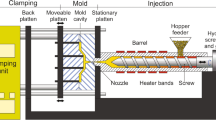Abstract
Weld lines are one of the typical quality issues of injection molded parts. They are unavoidable even for moderate complex products. To explore the formation of weld lines in injection molding, a flow model based on viscoelastic constitutive equation is presented in this article to predict and evaluate of weld lines location and properties, in which Rolie-Poly constitutive equation is used to describe the viscoelastic properties of polymer melts and level set method is used to capture melt front. Furthermore, the formation and evolution processes of weld lines are investigated by co-injection molding technique in simulation, since the processes are determined by the flow front and rheological history of the melt streams. Numerical results show that weld lines can be predicted accurately, and the formation and evolution processes of weld line can be shown more clearly by co-injection molding technique. In addition, properties of polymer melt such as velocity, pressure, principal stress difference, and molecular orientation in the weld line regions are investigated and presented.
















Similar content being viewed by others
References
Bociaga E, Jaruga T (2007) Experimental investigation of polymer flow in injection mould. Arch Mater Sci Eng 28(3):165–172
Chen X, Han P (2000) A note on the solution of conjugate heat transfer problems using SIMPLE-like algorithms. Int J Heat Fluid Flow 21(4):463–467
Chung C, Uneyama T, Masubuchi Y, Watanabe H (2011) Numerical study of chain conformation on shear banding using diffusive Rolie-Poly model. Rheol Acta 50(9–10):753–766
Fathi S, Behravesh AH (2008) Visualization analysis of flow behavior during weld-line formation in injection molding process. Polym-Plast Technol Eng 47(7):666–672
Fellahi S, Meddad A, Fisa B, Favis BD (1995) Weld lines in injection-molded parts: a review. Adv Polym Technol 14(3):169–195
Han J, Shen CY, Liu CT, Wang SJ, Chen JB (2008) Flow induced birefringence of weld line region in polystyrene injection molding. J Chem Ind Eng (China) 59(5):1305–1309
Hopmann C, Onken J (2018) Prediction of part geometry-dependent weld line strength in unreinforced polycarbonate. Adv Polym Technol 37(7):2579–2587
Jiang GS, Peng DP (2000) Weighted ENO schemes for Hamilton-Jacobi equations. SIAM J Sci Comput 21(6):2126–2143
Kobayashi Y, Teramoto G, Kanai T (2011) The unique flow of polypropylene at the weld line behind an obstacle in injection molding. Polym Eng Sci 51(3):526–531
Korichi A, Oufer L, Polidori G (2009) Heat transfer enhancement in self-sustained oscillatory flow in a grooved channel with oblique plates. Int J Heat Mass Transf 52(5–6):1138–1148
Li Q, Ouyang J, Wu GR, Xu XY (2011) Numerical simulation of melt filling and gas penetration in gas assisted injection molding. CMES Comp Model Eng 82(4):215–232
Likhtman AE, Graham RS (2003) Simple constitutive equation for linear polymer melts derived from molecular theory: Rolie-Poly equation. J Non-Newtonian Fluid Mech 114(1):1–12
Liu QS, Ouyang J, Zhou W, Xu XY, Zhang L (2015) Numerical simulation of the sequential coinjection molding process based on level set method. Polym Eng Sci 55(8):1707–1719
Liu QS, Ouyang J, Jiang CT, Zhuang X, Li WM (2016) Finite volume simulations of behavior for polystyrene in a cross-slot flow based on Rolie-Poly model. Rheol Acta 55(2):137–154
Liu QS, Liu YQ, Jiang CT, Wang XH (2019) Numerical simulation of viscoelastic flows during injection molding filling based on Rolie-Poly model. J Non-Newtonian Fluid Mech 263:140–153
Nguyen-Chung T (2004) Flow analysis of the weld line formation during injection mold filling of thermoplastics. Rheol Acta 43(3):240–245
Nguyen-Chung T, Plichta C, Plichta G (1998) Flow disturbance in polymer melt behind an obstacle. Rheol Acta 37(3):299–305
Nguyen-Chung T, Mennig G, Boyanova M, Fakirov S, Baltá Calleja FJ (2004) Effect of an obstacle during processing on the weld line of injection-molded glassy polystyrene: microhardness study. J Appl Polym Sci 92(5):3362–3367
Nie JH, Armaly BF (2002) Three-dimensional convective flow adjacent to backward-facing step-effects of step height. Int J Heat Mass Transf 45(12):2431–2438
Osher S, Shu CW (1991) High-order essentially nonoscillatory schemes for Hamilton-Jacobi equations. SIAM J Numer Anal 28(4):907–922
Prata AT, Sparrow EM (1984) Heat transfer and fluid flow characteristics for an annulus of periodically varying cross section. Numer Heat Transfer 7(3):285–304
Rhie CM, Chow WL (1983) Numerical study of the turbulent flow past an airfoil with trailing edge separation. AIAA J 21(11):1525–1532
Shu CW, Osher S (1988) Efficient implementation of essentially non-oscillatory shock-capturing schemes. J Comput Phys 77(2):439–471
Yamada K, Tomari K (2005) Fracture toughness evaluation of adjacent flow weld line in polystyrene by the SENB method. Polym Eng Sci 45(8):1059–1066
Yamada K, Tomari K, Ishiaku US, Hamada H (2005) Evaluation of mechanical properties of adjacent flow weld line. Polym Eng Sci 45(8):1180–1186
Yang BX, Ouyang J, Zheng SP, Li Q, Zhou W (2012) Simulation of polymer molding filling process with an adaptive weld line capturing algorithm. Int J Mater Form 5(1):25–37
Yang BX, Ouyang J, Wang F (2013) Simulation of stress distribution near weld line in the viscoelastic melt mold filling process. J Appl Math 2013:856171
Zheng SP, Ouyang J, Zhao ZF, Zhang L (2012) An adaptive method to capture weld lines during the injection mold filling. Comput Math Appl 64(9):2860–2870
Zhou HM, Li DQ (2004) Modelling and prediction of weld line location and properties based on injection moulding simulation. Int J Mater Prod Technol 21(6):526–538
Acknowledgments
This work is supported by Science and Technology Research Key Project of the Education Department of Henan Province (Grant No. 20A430023, 20B130002, 20A110031), National Natural Science Found Projects of China (11971075), and Nanhu Scholars Program for Young Scholars of Xinyang Normal University, which are gratefully acknowledged.
Author information
Authors and Affiliations
Corresponding author
Additional information
Publisher’s note
Springer Nature remains neutral with regard to jurisdictional claims in published maps and institutional affiliations.
Rights and permissions
About this article
Cite this article
Liu, Q., Liu, Y., Jiang, C. et al. Modeling and simulation of weld line location and properties during injection molding based on viscoelastic constitutive equation. Rheol Acta 59, 109–121 (2020). https://doi.org/10.1007/s00397-019-01182-8
Received:
Revised:
Accepted:
Published:
Issue Date:
DOI: https://doi.org/10.1007/s00397-019-01182-8




